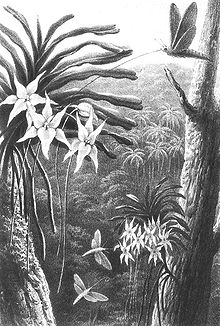- Xanthopan morgani
-
Xanthopan morgani 
Natural History Museum of London Scientific classification Kingdom: Animalia Phylum: Arthropoda Class: Insecta Order: Lepidoptera Family: Sphingidae Subfamily: Sphinginae Genus: Xanthopan
Rothschild & Jordan, 1903Species: X. morgani Binomial name Xanthopan morgani
(Walker, 1856)Synonyms Xanthopan morganii
Xanthopan morganii praedicta Rothschild & Jordan, 1903Xanthopan morgani, or Morgan's Sphinx, is a very large hawk moth from West Africa (Rhodesia, Nyasaland) and Madagascar. It is the sole member of its genus, and little is known of the biology, though the adults have been found to visit orchids (see below).
In January 1862 while researching insect pollination of orchids, Charles Darwin received a package of orchids from the distinguished horticulturist James Bateman, and in a follow up letter with a second package Bateman's son Robert confirmed the names of the specimens, including Angraecum sesquipedale from Madagascar.[2][3] Darwin was surprised at the defining characteristic of this species: the "astonishing length" of the whip-like green spur forming the nectary of each flower, and remarked to Joseph Hooker "I have just received such a Box full from Mr Bateman with the astounding Angræcum sesquipedalia with a nectary a foot long— Good Heavens what insect can suck it"[?][4] The spur of the flower is 20–35 cm (7.9–14 in) from its tip to the tip of the flower's lip. The name "sesquipedale" is Latin for "one and a half feet," referring to the spur length.
From his observations and experiments with pushing a probe into the spur of the flower, Darwin surmised in his 1862 book Fertilisation of Orchids that there must be a pollinator moth with a proboscis long enough to reach the nectar at the end of the spur.[5] In its attempt to get the nectar at the end of the spur the moth would get pollen rubbed off on its head. The next orchid it visited would then be pollinated in the same manner.[1]
In 1903, such a moth was discovered in Madagascar. It was described as a sub-species of the African hawk moth and named Xanthopan morganii praedicta. The subspecific epithet "praedicta" was given in honor of the fact that Darwin predicted its existence, though the subspecies was later determined to be invalid (it is identical to the mainland form of the species). The moth approaches the flower to ascertain by scent whether or not it is the correct orchid species. Then the moth backs up over a foot and unrolls its proboscis, then flies forward, inserting it into the orchid's spur.
The larvae feed on Annona senegalensis, Hexalobus crispiflorus, Uvaria, Ibaria and Xylopia species.[6]
Source
References
- ^ a b Kritsky, Gene (1991). "Darwin's Madagascan Hawk Moth prediction". American Entomologist 37: pp. 206–9. http://www.darwinproject.ac.uk/images/darwinsmoth_optimised.pdf. Retrieved 2009-02-09
- ^ "Darwin Correspondence Project - Letter 3357 — Bateman, Robert to Darwin, C. R., (1862)". http://www.darwinproject.ac.uk/darwinletters/calendar/entry-3357.html#mark-3357.f2. Retrieved 2009-02-09.
- ^ "Darwin Correspondence Project - Letter 3356 — Bateman, James to Darwin, C. R., (1862)". http://www.darwinproject.ac.uk/darwinletters/calendar/entry-3356.html. Retrieved 2009-02-09.
- ^ "Darwin Correspondence Project - Letter 3411 — Darwin, C. R. to Hooker, J. D., 25 Jan (1862)". http://www.darwinproject.ac.uk/darwinletters/calendar/entry-3411.html. Retrieved 2009-02-09.
- ^ Darwin 1862, pp. 197–203
- ^ Afromoths[dead link]
Categories:- Sphingini
- Butterflies and moths of Africa
- Animals described in 1856
Wikimedia Foundation. 2010.

